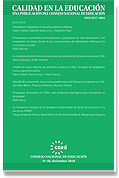Inmigrants Students in Chilean Public Schools
DOI:
https://doi.org/10.31619/caledu.n49.575Keywords:
education, inclusion, immigrationAbstract
The article analyzes the school process of migrant children, based on observed interrelations between students, to provide insights that could strengthen inclusion dynamics within the Chilean school system. Its thematic relevance derives from the social consequences of the social exclusion of minorities in the school context. Methodologically, it is a descriptive-correlational work, which explains existing interrelations between educational and social factors, to understand the school dynamics of migrant and local students.
Through a mixed approach, the results show the complex network of social and school representations associated with migration and retention in the formal school system, as well as the difficulties of including migrant collectives in the daily dynamics of play and work in school spaces. These difficulties are related to the migrant student"s concentration in the classrooms, gender and the specific migrant collective to which he or she belongs. The study also shows that schools do not have specific policies that organize and structure what many try to do regarding the inclusion of immigrant students and collaborative interaction between the different actors in the classroom and schools.
Downloads
Published
Issue
Section
License
Authors retain their Copyright and only transfer a part of these to the journal, accepting the following conditions:
Authors keep their rights as authors and guarantee the right to the journal for the first publication of their work, which is simultaneously subject to the Creative Commons Attribution license allowing third parties to share the study accrediting the author and first publication in this journal.
Authors may adopt other non-exclusive license agreements for distribution of the version of the published work (e.g. inclusion in an institutional thematic file or publication in a monographic volume) accrediting initial publication in this journal.
Authors are allowed and recommended to share their work over the Internet (e.g. in institutional telematic files or their website) before and during the submission process, which may lead to interesting exchanges and increased citation of the published work. (See The effect of open access).

